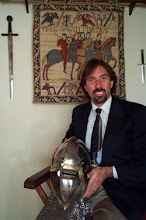Pushing The Pram A Lot
Yesterday I had the opportunity to give a presentation for students at CSU Long Beach on a delightful subject: Arthurian legend and Monty Python and the Holy Grail. (The on-campus branch of the SCA [a historical reenactment club] was hosting a screening of the movie.)
Not wanting to get in the way of the movie ('cuz MP is far more enjoyable and entertaining than me) I tried to keep my comments brief - I just talked (mainly) about the symbolism in one scene of the movie: the famous "black knight" skit.
In the movie, King Arthur comes to a bridge, and is challenged by an anonymous Black Knight to a duel in order to cross the bridge. A common enough occurrence in most traditional Arthurian myths - but THG isn't about "tradition" ... it's focus is on deconstructing and undermining the traditional themes of Arthurian legends, as a way of deconstructing and undermining the symbols and presumptions of traditional politics and social values. In this regard, THG is very much a product and a reflection of its time period - the early 70s, when Watergate and Vietnam were still very much "current events."
So - back to the Black Knight. In traditional Arthurian narrative, the Round Table hero (in this case, Arthur) would have fought the challenger, dealt him a "grievous wound," and knelt down and prayed for his recovery - and as a result the Black Knight would have been beholden to King Arthur, and might even have subsequently been dubbed as a Knight of the Round Table. In this regard, Arthur would have demonstrated the rightness of his cause (chivalric virtue) through military might (the duel) and indoctrinated an otherwise violent interloper (the Black Knight) into his civilized court (Camelot/the Round Table).
But not in Monty Python ...
Here, after delivering a grievous wound ("I've cut your bloody leg off" ... "no you haven't!"), Arthur kneels down to pray, but the knight continues taunting and physically assaulting the king. Arthur proceeds to chop away at every other appendage, but none of these wounds seem to have any effect on the Black Knight's ability to continue fighting. Even when the Black Knight is nothing but a limbless torso, he continues to tell Arthur he'll "bite (his) kneecaps off" as the king shakes his head and trots away.
A uniquely hilarious scene, to be sure, but the comedy becomes all the more brilliant when you look at this as a metaphor for the American experience in Vietnam. A superior military force deals a series of debilitating wounds to its adversary, but becomes increasingly frustrated and baffled when the enemy won't quit the field. Finally the "winning" force tromps away in confusion, not quite sure how they could be successful in every engagement, and still have victory essentially denied to them.
There are lots of other wonderful metaphors in the film - Bedevere as a critique of the assumption that science and technology can solve every problem; Zoot and the damsels of Castle Anthrax as an emblem of the sexual revolution - but at its heart, THG brings to light a new approach to assumptions about established authority. It's no coincidence that this movie is a product of a time period that rattled long-held beliefs about the benevolent intentions of unchecked authority. More than three decades later, pretty much everyone has come to believe that even the most noble and honest leaders need oversight and transparency in order to achieve trust and respect.
And in that regard, the humor of Monty Python and the Holy Grail helped to add a new chapter and a deeper understanding to the value of chivalry today.
Look for more on this topic in a future edition of our podcast, when Prof. Gary Hardcastle, editor of the book "Monty Python and Philosophy" joins us to talk about the Pythonian take on the Code of Chivalry.
Labels: Holy Grail, King Arthur, Monty Python


2 Comments:
This comment has been removed by a blog administrator.
Scott,
Entertaining and thoughtful! Thanks for letting me reprint this as a review at Troynovant.
Post a Comment
Subscribe to Post Comments [Atom]
<< Home